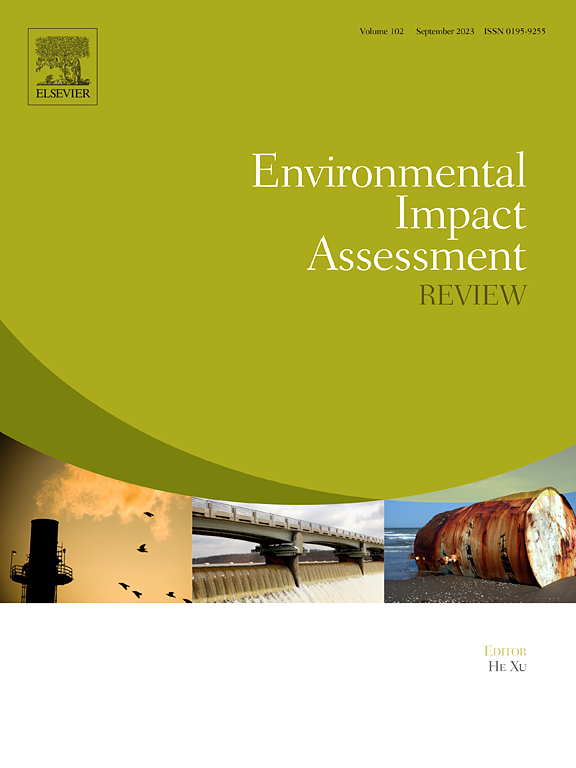Comprehensive evaluation of CCUS technology: A case study of China's first million-tonne CCUS-EOR project
IF 11.2
1区 社会学
Q1 ENVIRONMENTAL STUDIES
引用次数: 0
Abstract
CCUS, an emerging technology for reducing carbon emission, plays a crucial role in achieving the goal of carbon neutrality. CCUS technology exemplified by CO2 enhanced oil recovery (EOR) is gradually progressing from project demonstration to large-scale application. However, the commercial application still faces uncertainties in economic cost, energy efficiency and environmental benefits. This paper takes China's first million-tonne CCUS-EOR project (Qilu Petrochemical-Shengli Oilfield CCUS-EOR project) as an example, and establishes a comprehensive research framework for evaluating CCUS from the three dimensions of energy, environment, and economy, based on economic viability, energy input-output analysis, and carbon input-output analysis. The results demonstrate that during the project lifecycle, when the average oil price is $90/bbl, the project's NPV is $56.09 million, the project's IRR is 13.4 %, the payback period is 8.34 years, and the threshold oil price for the project to be economically profitable is $81.52/bbl. Furthermore, the Energy Return on Investment (EROI) of the project is 9.09, which considerably superior to that of the Shengli Oilfield's non-EOR, and the net energy output is approximately 18,472.57 kilobarrels. The Carbon Return on Investment (CROI) of the project is 4.12, with significant environmental benefits, and the cumulative net carbon emission reduction is approximately 8078.55 kilotonnes. Furthermore, the trends in EROI and CROI of the CCUS-EOR project demonstrate nearly opposite trajectories. The variation trends in EROI emerge N-shaped curve, while that of CROI emerge S-shaped curve. In summary, the Qilu Petrochemical-Shengli Oilfield CCUS-EOR project exhibits notable advantages in terms of energy efficiency and environmental benefits. However, the threshold oil price for triggering economic profitability is relatively high, which may pose certain economic risks to investors during periods of low oil price.
全面评估 CCUS 技术:中国首个百万吨级 CCUS-EOR 项目案例研究
CCUS 作为一种新兴的碳减排技术,在实现碳中和目标方面发挥着至关重要的作用。以二氧化碳提高石油采收率(EOR)为代表的 CCUS 技术正逐步从项目示范走向大规模应用。然而,商业应用在经济成本、能源效率和环境效益等方面仍面临不确定性。本文以中国首个百万吨级CCUS-EOR项目(齐鲁石化-胜利油田CCUS-EOR项目)为例,从经济可行性、能源投入产出分析和碳投入产出分析三个维度,建立了从能源、环境和经济三个维度评价CCUS的综合研究框架。结果表明,在项目生命周期内,当平均油价为 90 美元/桶时,项目的净现值为 5609 万美元,项目的内部收益率为 13.4%,投资回收期为 8.34 年,项目经济盈利的临界油价为 81.52 美元/桶。此外,项目的能源投资回报率(EROI)为 9.09,大大优于胜利油田非 EOR 项目,净能源产出约为 18,472.57 千桶。项目的碳投资回报率(CROI)为 4.12,环境效益显著,累计净碳减排量约为 8078.55 千吨。此外,CCUS-EOR 项目的 EROI 和 CROI 变化趋势呈现出几乎相反的轨迹。EROI的变化趋势呈 "N "形曲线,而CROI的变化趋势呈 "S "形曲线。总之,齐鲁石化-胜利油田 CCUS-EOR 项目在能源效率和环境效益方面具有显著优势。但是,触发经济收益的临界油价相对较高,在低油价时期可能会给投资者带来一定的经济风险。
本文章由计算机程序翻译,如有差异,请以英文原文为准。
求助全文
约1分钟内获得全文
求助全文
来源期刊

Environmental Impact Assessment Review
ENVIRONMENTAL STUDIES-
CiteScore
12.60
自引率
10.10%
发文量
200
审稿时长
33 days
期刊介绍:
Environmental Impact Assessment Review is an interdisciplinary journal that serves a global audience of practitioners, policymakers, and academics involved in assessing the environmental impact of policies, projects, processes, and products. The journal focuses on innovative theory and practice in environmental impact assessment (EIA). Papers are expected to present innovative ideas, be topical, and coherent. The journal emphasizes concepts, methods, techniques, approaches, and systems related to EIA theory and practice.
 求助内容:
求助内容: 应助结果提醒方式:
应助结果提醒方式:


